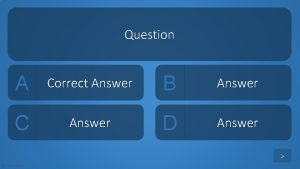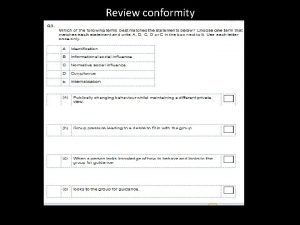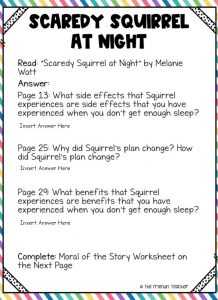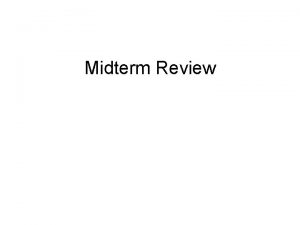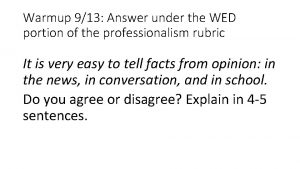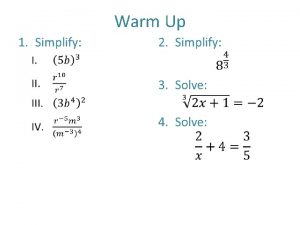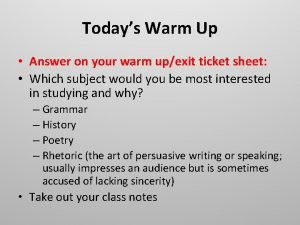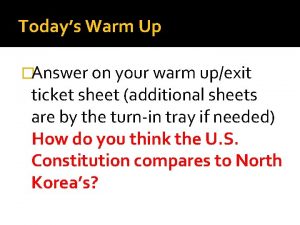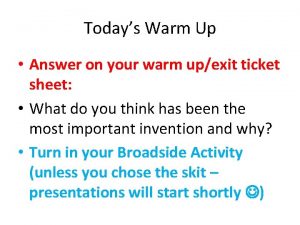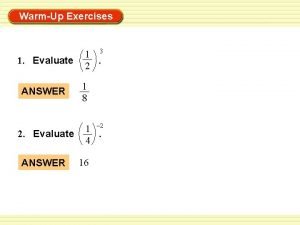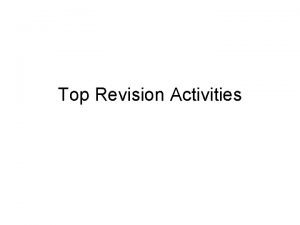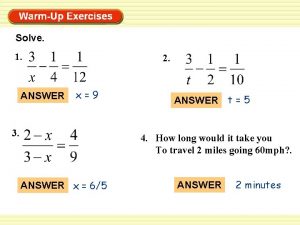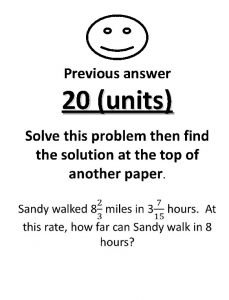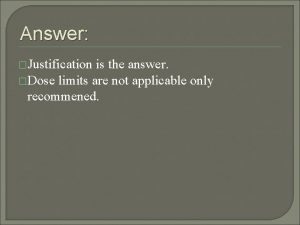Warm Up Answer in the warm up portion










































- Slides: 42

Warm Up • Answer in the warm up portion of your worksheet. • Work with your small group, have answers written on your paper. • What are some examples of primary and secondary sources that you have worked with in social studies?

Primary Sources you have used Secondary Sources you have used a source for historical study written after sources written by people who participated the event it describes, usually with the aid in or observed the events they describe of a primary source

Objective • Historians will be able to identify and distinguish between primary and secondary sources, and how historians use them through a reading response, and source analysis activity.

Reading • Open up Across the Centuries and read pages 16 -17 • Fill in the chart (non-written sources, written primary, written secondary sources)

Whiteboard Washout Primary or Secondary? Identify each of the following artifacts as either primary or secondary sources of information and explain why each artifact fits into that category.
















• Nonwritten sources • help us with prehistory. Fossils, ruins, and artifacts • Written primary sources • sources written by people who participated in or observed the events they describe • A sailor writing about a voyage, an explorer writing about a new place they are exploring

• Written secondary source • a source for historical study written after the event it describes, usually with the aid of a primary source. • A girl writing about stories her grandmother told her • A historian researching what someone else wrote

Discovery Ed Video • After viewing this video, answer the question below your warm up question. • CC_Primary_2 Mb. mp 4 • Why are secondary sources still useful for historians? • • • Analyze the primary sources-can turn up new information/insights about that event If the primary source is destroyed you still have information about it in the 2 ndary. Historians combine all of the primary sources to get a complete story

Read pages 18 -19 and answer the three questions on your worksheet • Why are primary sources generally more accurate than secondary sources? – People who actually saw or took part usually tell a more accurate story • Why don’t all people who take part in an event have the same view of that event? – They don’t have the same background- a loser of a battle will have a different view than the winner. • Why can’t a final history of the past be written? – There will always be new sources to study, new questions to ask, and new points of view about what things mean to us or to people back then.

Conclusions… 1. In your own words define a primary source. 2. In your own words define what a secondary source is. 3. What are some of the pros and cons of using primary vs secondary sources?

Primary Sources Secondary Sources +Information is from the time period/place +More information because it compiles of the event different primary sources +Original (more likely to get a more complete picture, than just one primary source) +Gives insights about what people were thinking then +Experts research the primary sources - Can have bias, exaggeration, lies +Exaggeration/lies should be less -Different points of vies/conflicting views (Not the whole picture) -Not from the event, so details and points of view may be missing -Authors can misinterpret information or different authors have different interpretations

Warm Up • What things must historians keep in mind when they study the past? • Who is the source? Are they accurate/trustworthy? • Are there any views not included? • When was it made? • Why was it made? • What does it tell us?

Historians will be able to identify similarities and differences, seek answers to questions left unanswered in the sources, and defend a claim on which type of source is most accurate.

Source Analysis • Today we will be questioning sources to determine what they tell us about different cultures, but also what they do not tell us. • We will start with the Byzantine Empire • Together as a class we will analyze three sources and then you will be broken into small groups to analyze other cultures. • Be prepared to share out to the whole class when we finish.

Source 1 Mosaic of Justinian


Source 2 Excerpt from Procopius description of Justinian As to the belief that a woman should not be daring among men or asset herself boldly, I consider the present crisis does not allow us to debate that. My opinon is that now is a poor time for flight, even though it bring safety…. If now you wish to go, Emperor, nothing prevents you. There is the sea, there ar the steps to the boats. But take care that after you are safe, you do not find that you would gladly exchange that safety for death. For my part, I like the old saying that “The Empire is fine burial cloth. ” Recorded by Procopius, circa 550


Source 3 Page 43 Across the Centuries

Group Analysis You will be divided into different groups and you will analyze three sources. Be sure to complete your charts and answer the two reflection questions at the bottom.

Class 1 Africa Group 2 Europe Group 1 Europe Group 2 Japan Group 1 Japan Group 2 Shayla Paige Aiden Emma Sophia Matt Allision Collin Ryder Donte Maddy Luke Ashlyn Brianna Courtney Riley Connor Symera Hasibur Braden Cailey Jon Connor J Scott

Class 2 Africa Group 1 Europe Group 1 Japan Group 1 Gunnar Olivia Kayla Emily Mason Ryleigh Julia Haley Haris Carter Kaylen Jalen Gina Logan Micah

Class 3 Africa Group 1 Africa Group 2 Europe Group 1 Europe Group 2 Japan Group 1 Japan Group 2 Nancy Cameron Connor Camryn Shawn Ashby Chase Elizabeth Elana Tara Jackson Sidney Kailey Julianna Gavin Hannah John Christian

Class 4 Africa Group 1 Africa Group 2 Europe Group 1 Europe Group 2 Japan Group 1 Japan Group 2 Allison Grayson G Dalton Maddy Alyson Mara Luke Grayson B CJ Lily Emma Megan Brandon Casey Bryce Sophie Evan Katherin Madison Ashley Ben

Based on the source analysis activity, what similarities and differences do you notice between primary and secondary sources?

What type of source was the easiest to understand use? Which type of source gave you the clearest information about your unit of study?

Exit Ticket Which type of source (Primary or Secondary) provides the most accurate depiction of the cultures you will be exploring this school year. Defend your choice with at least 2 reasons using evidence from our classroom learning. Stick your response in the primary or secondary pile. 4 Exceptional Composing the Claim The claim completely answers the question and demonstrates relevant reasoning. 3 Experienced The claim completely answers the question and attempts to demonstrate relevant reasoning. 2 Emerging 1 Beginning The claim answers the question. The claim does not answer the question or is irrelevant to the text. 0 Insufficient Response A claim is not stated.
 Hát kết hợp bộ gõ cơ thể
Hát kết hợp bộ gõ cơ thể Bổ thể
Bổ thể Tỉ lệ cơ thể trẻ em
Tỉ lệ cơ thể trẻ em Chó sói
Chó sói Tư thế worm breton là gì
Tư thế worm breton là gì Chúa sống lại
Chúa sống lại Các môn thể thao bắt đầu bằng tiếng nhảy
Các môn thể thao bắt đầu bằng tiếng nhảy Thế nào là hệ số cao nhất
Thế nào là hệ số cao nhất Các châu lục và đại dương trên thế giới
Các châu lục và đại dương trên thế giới Công của trọng lực
Công của trọng lực Trời xanh đây là của chúng ta thể thơ
Trời xanh đây là của chúng ta thể thơ Cách giải mật thư tọa độ
Cách giải mật thư tọa độ Phép trừ bù
Phép trừ bù Phản ứng thế ankan
Phản ứng thế ankan Các châu lục và đại dương trên thế giới
Các châu lục và đại dương trên thế giới Thơ thất ngôn tứ tuyệt đường luật
Thơ thất ngôn tứ tuyệt đường luật Quá trình desamine hóa có thể tạo ra
Quá trình desamine hóa có thể tạo ra Một số thể thơ truyền thống
Một số thể thơ truyền thống Cái miệng xinh xinh thế chỉ nói điều hay thôi
Cái miệng xinh xinh thế chỉ nói điều hay thôi Vẽ hình chiếu vuông góc của vật thể sau
Vẽ hình chiếu vuông góc của vật thể sau Nguyên nhân của sự mỏi cơ sinh 8
Nguyên nhân của sự mỏi cơ sinh 8 đặc điểm cơ thể của người tối cổ
đặc điểm cơ thể của người tối cổ V. c c
V. c c Vẽ hình chiếu đứng bằng cạnh của vật thể
Vẽ hình chiếu đứng bằng cạnh của vật thể Tia chieu sa te
Tia chieu sa te Thẻ vin
Thẻ vin đại từ thay thế
đại từ thay thế điện thế nghỉ
điện thế nghỉ Tư thế ngồi viết
Tư thế ngồi viết Diễn thế sinh thái là
Diễn thế sinh thái là Các loại đột biến cấu trúc nhiễm sắc thể
Các loại đột biến cấu trúc nhiễm sắc thể So nguyen to
So nguyen to Tư thế ngồi viết
Tư thế ngồi viết Lời thề hippocrates
Lời thề hippocrates Thiếu nhi thế giới liên hoan
Thiếu nhi thế giới liên hoan ưu thế lai là gì
ưu thế lai là gì Hươu thường đẻ mỗi lứa mấy con
Hươu thường đẻ mỗi lứa mấy con Khi nào hổ mẹ dạy hổ con săn mồi
Khi nào hổ mẹ dạy hổ con săn mồi Sơ đồ cơ thể người
Sơ đồ cơ thể người Từ ngữ thể hiện lòng nhân hậu
Từ ngữ thể hiện lòng nhân hậu Thế nào là mạng điện lắp đặt kiểu nổi
Thế nào là mạng điện lắp đặt kiểu nổi Food chain essential questions
Food chain essential questions










































